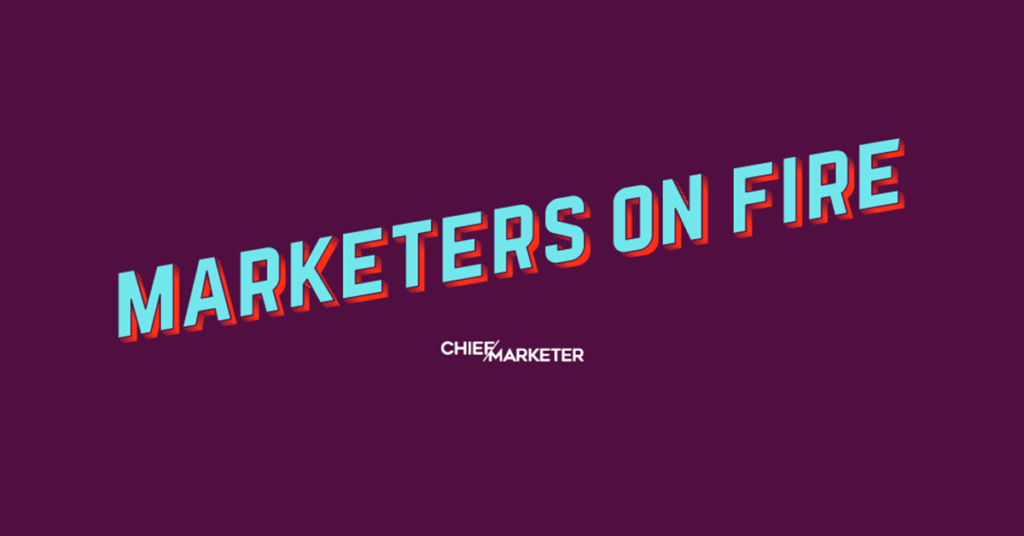At a time when scores of consumers are reevaluating their occupations and considering employment options that are more rewarding and meaningful to them, owning a platform that helps entrepreneurs start and run new businesses is not a bad place to be. One such platform, ZenBusiness, has reaped the benefits, reporting a 400 percent growth in customers since March 2020. According to brand surveys, 49 percent of its customers say the pandemic gave them the inspiration to start their own business.
But marketing the service poses a unique set of challenges. We spoke with ZenBusiness Co-founder and CMO Ryan Pitylak about the company’s marketing journey; why emotionally-resonant creative is so critical to the brand-building process; the significance of unit economics and lifetime value metrics; and how the brand is approaching identity-based measurement.
Chief Marketer: What role does data play in your marketing strategy and programs?

Ryan Pitylak, ZenBusiness Co-founder and CMO: Data underpins everything we do here at ZenBusiness. First, it starts with understanding how the market is shaping our business in particular, because the entry point for people with our brand is at the point of business formation. The number of new business formations that are happening each month matters, and also how much people are seeking work outside of their day job. So, what’s the trend that’s happening with side hustles? Then ultimately, we look at each cohort of customers—every month’s worth of customers—and get an understanding of what they are purchasing and how they are using our platform, and what the renewal looks like.
What we’re trying to do here is driven by the goal of helping people become successful business owners. We also take a look at how well people are doing, how successfully they’re getting to their first dollar, and onwards. Because this guiding principle of helping businesses be successful is at our core.
CM: What tactics do you use to determine what your customers’ needs are? How do you interact with them and use that data?
RP: We do a lot of different things to get a pulse of what our customers care about. That starts with both quantitative and qualitatively research. For every new product that we’re rolling out, we want to know which features are most important to the customer, and how they may value those features and the combination of them so that we can figure out how to price effectively.
The other major piece is qualitative. Absolutely nothing substitutes for just getting on the phone and talking with people. This can be done as part of a broader study. So, maybe we’ll talk to 20 different people and ask them a structured set of questions so that we can get a pretty rich readout of how a broader cross section of people feel about what we’re trying to accomplish, and even get their feedback on designs and feature functionality usage.
We also do a lot of research around the journey that people are on. When you’re starting a business, that idea starts well before you are actually working on the business, and before you go on form as a company and start finding your first customers. We found it incredibly helpful to understand that journey and how it varies for different customer segments so that we can most appropriately communicate with people at the right time and offer them what they want at different points in the journey—which at some points might just be support and education, and not something that financially benefits us, but gives them value while they’re on their journey.
CM: The job market is a lot different than it was two years ago, with more people reconsidering their options for employment. Has the pandemic actually helped your business?
RP: COVID-19 caused people to start new businesses in a way that we’ve never seen. It happened pretty immediately following the beginning of the pandemic—as early as May of 2020. What’s interesting is that that trend has continued. There has been a shift in the way that people think about work. I think that there are several reasons why this has happened, one of which is that the pandemic in some ways forced—but also enabled—people to take a hard look at their lives and look for ways to make themselves happier. There was an article out recently in the Wall Street Journal about how 50 percent of people in their day job are completely unhappy with that job. And that’s part of what leads to the Great Resignation.
But you ask people who are entrepreneurs, and they’re happy and motivated and excited about this transition to becoming their own boss. We see ourselves as an instrument of change in this trend. And ultimately, if we get it right, we want to be able to fundamentally change the way that people work so that no longer do you have to work for some employer that may not care about you. You actually get to do what you love and build it up to be as big as you want and create the flexibility that you want—especially in these times. I see this as a “forever change,” and I’m excited that we get to help entrepreneurs on this journey. It’s our mission to unleash this entrepreneur that’s in each of us.
CM: What’s your approach when it comes to brand-building?
RP: There’s this concept of brand marketing and performance marketing—and the reality is that the distinction is a little arbitrary. We think about collapsing this distinction between them, because all marketing needs to perform, especially for a business like ours with very ambitious objectives. I think about the role of the different channels. We’re now moving into video advertising more significantly, which started by including digital channels like YouTube and working with influencers. It’s now expanding into more streaming video and over-the-top-type advertising and hiring a full-suite creative agency to make creative that’s highly resonant.
For 85 percent of businesses that get formed, it’s the person’s first time doing it. So, somewhat by definition, it’s an action that you might only do one time in your life. It’s incredibly infrequent. As a result, from a marketing standpoint, it’s important that as we start to move into awareness-oriented marketing, the creative works extra hard and connects with somebody on an emotional level so that they’ll actually remember us when they’re going into Google to go make a search and make a purchase.
CM: So, some customers are not necessarily repeat customers.
RP: As a platform company, people typically are signing up for subscriptions with us. We provide them with company entity management services or website services, or financial technology services, like invoicing and payments and accounting and tax, and other things to help them manage their business on a day-to-day basis. So, we do have an ongoing relationship with our customers, and they do purchase more things over time. But the most important thing to do when growing any brand is to bring in net new customers. It has to be the number one job for the marketer.
Google ran a study which is really interesting. The reason why the investment in awareness media is so important is that when people go to Google to make a search, 66 percent of the time they already have a brand in mind, and 94 percent of that 66 percent end up sticking with that brand. If you’re going to grow your business, you have to get your brand into the minds of potential customers, otherwise you’re missing out on two thirds of the potential.
CM: Shifting gears to measurement… Can you talk about the significance of unit economics and lifetime value in relation to your measurement strategy?
RP: It’s important to have a complete measurement framework in place. It’s easy to just look at short-term measures of advertising performance, like how many clicks or conversions I got from this advertising. That works extremely well when you’re looking at advertising channels like Google. When you start to move into a more balanced approach to marketing, and reaching people across many different advertising channels, then you need to have a complete framework in place.
One of the metrics that you look at is unit economics, and everything ladders up to that. The role of advertising should be to drive new customers, and that is measured by the number of customers that the advertising drove in the short-term. But then you also want to look at these longer-term measurement items, like unaided awareness, intent to purchase, brand favorability, and other brand health metrics. There’s this concept called ad stock, which is how much media has been delivered, and what has happened to the level of awareness as a result and how much media do you need to have in the market to maintain that level of awareness.
With unit economics, one of the first ratios that people care about is the lifetime value to customer acquisition cost ratio—the LTV to CAC ratio. And the other metric is what we call CAC payback, or customer acquisition cost payback. When I say LTV, typically we’re talking about first-year LTV. In a business like ours, that has a subscription service element, we make money from our customers over time. But the reason why looking at first-year LTV can be so important when thinking about the effectiveness of your advertising is because you ideally want the money that you spend in advertising to be recuperated by the revenue that you get from your customers fairly quickly. That’s why we look at these ratios. They are the guardrails for the types of channels we can advertise in, and how aggressively we can go into the market to acquire new customers.
CM: In light of the company’s impressive growth, any lessons learned from focusing on these metrics?
RP: The big lesson for me is that increasing that first-year lifetime value is the path for making room to have enough money available to buy more customers. You want to find ways to deliver value to your customers so that they’re willing to pay you more. And then that opens up a world of possibilities in terms of the ways in which you can reach people in the market.
CM: When we spoke about the top trends in marketing right now for our recent executive roundup, you touched on the increased need for measurement and accountability of marketing spend. What’s your approach to identity-based measurement? Do you have any recommendations for marketers?
RP: It’s definitely top of everybody’s mind. The real impact of all this is probably going to be felt the most in about a year, when Google starts to change some of its rules related to cookies. But there have already been a lot of changes led by Apple, around Safari on your mobile device, for example. There’s already a loss of data if you’re just relying on cookies. If you’re going to have any chance at competing effectively with other major brands, then you need to understand the contribution that each advertising channel is having towards driving you new customers. And that can be difficult when you’re looking at advertising that’s being delivered across so many channels, including TV.
The best measurement frameworks are not relying on cookies. There are identity companies out there. I think two of the companies that are the best in this area are Neustar and Visual IQ. Neustar has an identity-based framework, because they power a lot of Know Your Customer (KYC) for banks, phone companies… it’s incredible how much data they have. They map all the different advertising to this person at the core, and then the marketer understands the contribution that every single channel had.
Furthermore, with Facebook, almost nobody has the ability to know when a particular person has viewed an ad. Visual IQ and Neustar have gotten behind the walled garden of Facebook and many other platforms, and those platforms trust Neustar because of their strength in maintaining the integrity of people’s data and identity. As marketers, we can actually get visibility into that. The ability to make smart investment decisions and media allocation decisions, and to be able to forecast appropriately, is all made possible with this foundation.
CM: Another trend you cited was the need for companies to do good in the world. If a brand is not hitting the mark in terms of resonating with its purpose, do you have advice?
RP: I’ll start by talking a little bit about our brand. We are a Public Benefit Corp., and that means that in our charter, we have a responsibility to all of our stakeholders. This stakeholder model is extremely powerful. It has to start at the top; people in leadership at the company have to believe that a company’s job is to do some level of good in the world. In our case, we enable people to take control of their lives and be happier, because they are able to become their own boss. And we will stop at nothing to empower people to be successful in that journey.
We think about our decisions through that lens. The investments that we made in ZenBusiness Academy, for example, which is education, and the future investments that we’re making in both the platform and different ways of giving back and connecting with our customers, are all with that framework in mind. And they may not always have a profit motive associated with it.
There are so many great things that come from being a business that has made a decision to do that, [such as] the ability to attract employees who feel like they want to make a difference in the world. When scrutinized by discerning buyers, like millennial and Gen Z shoppers, who care about buying from companies that align with their values, then we have the opportunity to win—especially against some large corporation that doesn’t really seem to care about its customers.
To answer your question about a company that may be looking to identify and find purpose, I would say, honestly, it has to start at the top. There’s a great book called Conscious Capitalism, written by John Mackey. It talks about the stakeholder model and how it can help an executive who’s trying to wrap their arms around how to do more good in the world with their company and a framework for that.
CM: Last question: What excites you the most about the marketing industry right now?
RP: There’s so many, but this is a trend that’s been emerging and the impact of it is going to be very broad. And that’s the rise of streaming video. Linear TV has been on the decline, and it’s notoriously difficult to measure. It’s possible to measure it, but it involves a lot of sampling. Streaming video is an amazing ad unit because it’s full screen, you have the person’s attention because they’re waiting to watch the rest of their show, and it’s not skippable like linear TV. As a result, you have an opportunity to make an impact with your advertising, and you can do it in a visual and audio way.
Furthermore, it’s addressable, meaning I can target specific people. If you’re watching a show, you might see a different ad than another person watching the same show. As a marketer, I have so much flexibility around showing my advertisement to the right person in the right context, in an ad unit that is immersive. And it’s growing like crazy, because people are cutting cords and moving over to app-based streaming. That’s a trend that is going to continue. I’m seeing it become an important part of a marketer’s media mix.





